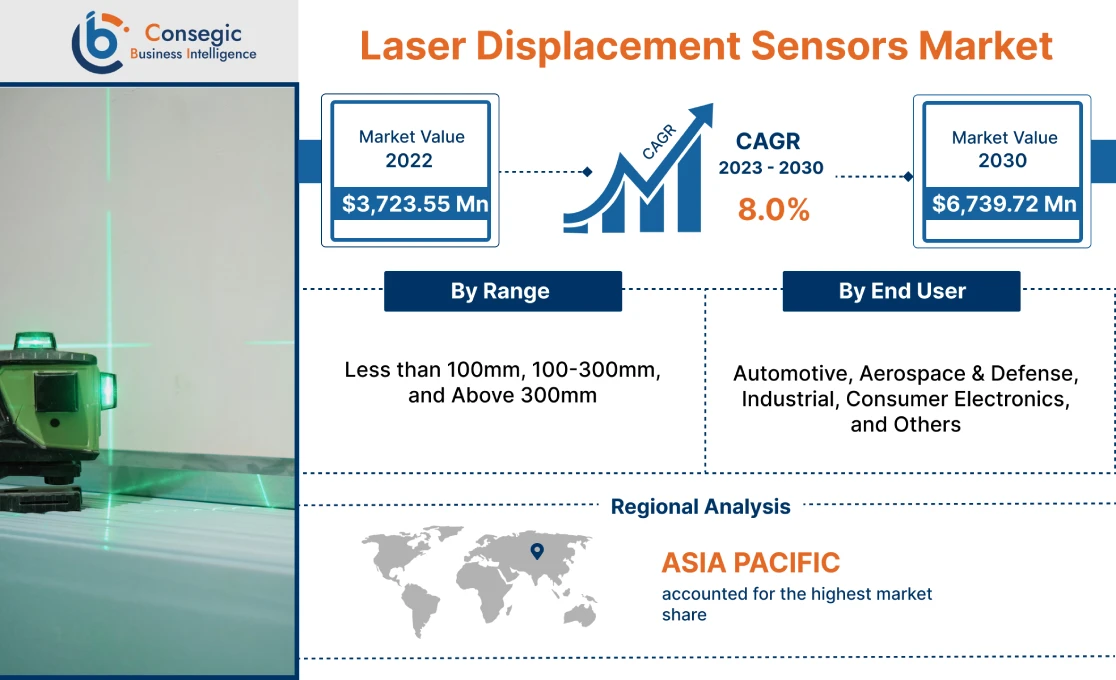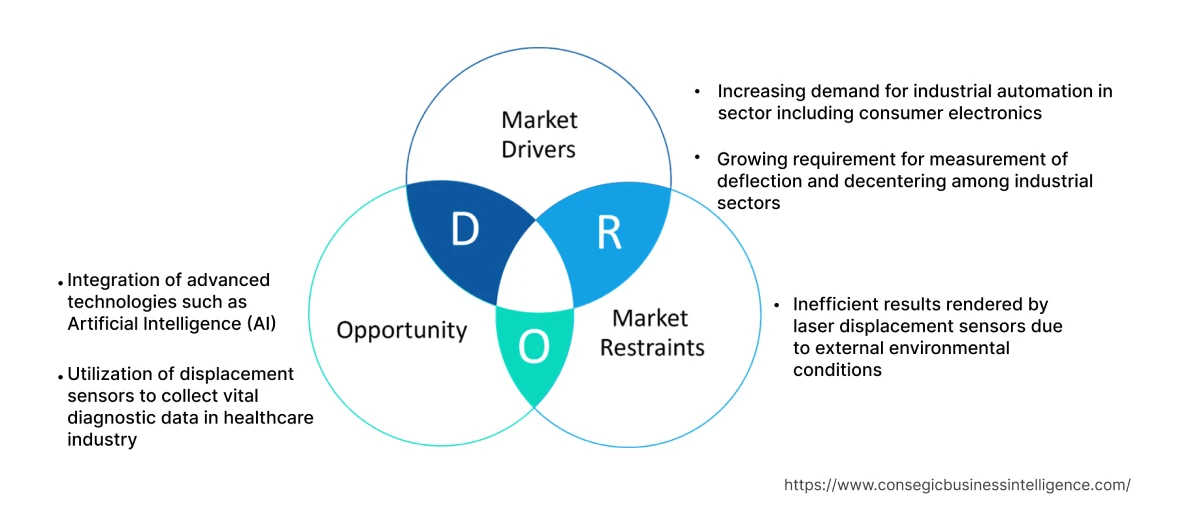Laser Displacement Sensors Market Size :
Laser Displacement Sensors Market size is estimated to reach over USD 6,739.72 Million by 2030 from a value of USD 3,723.55 Million in 2022, growing at a CAGR of 8.0% from 2023 to 2030.
Laser Displacement Sensors Market Scope & Overview:
A laser displacement sensor is a device that utilizes laser technology for measuring a single point using triangular reflection. Moreover, laser displacement sensors are also known as laser pointers and have the capabilities to generate 2D and 3D surface presentation of small, medium, and large size equipment. Apart from aforementioned capabilities, such sensors are applied to obtain object's width, height, area, angle, and position and consists of three components such as laser, laser detector, and a measuring circuit. Consequently, laser displacement sensor is deployed to determine the height, width, and thickness of an object in addition to the range of motion relative to object in motion.
Laser Displacement Sensors Market Insights :
Laser Displacement Sensors Market Dynamics - (DRO) :
Key Drivers :
Increasing demand for industrial automation in sector including consumer electronics
The increasing adoption of laser displacement sensors in consumer electronics for measuring parameters such as length, width, and thickness owing to growing demand for higher accuracy and product sustainability is driving the growth of laser displacement market. Accordingly, the aforesaid criteria are being fulfilled by laser displacement sensors for accurate measuring of touch panels surface height and air gap in consumer electronic products including smartphone, tablets, and others. For instance, in September 2022, Solartron Metrology introduced two compact non-contact laser triangulation displacement sensors, to enhance accuracy and efficiency of manufacturing automation process control. Thus, devices are increasingly being employed in sectors including consumer electronics for better efficiency and accurate measurement, ultimately driving the growth for laser displacement sensor market.
Growing requirement for measurement of deflection and decentering among industrial sectors
Deflection and decentering are mainly defined as movement of an object from its central position. In order to accurately measure deflection and decentering, laser displacement sensors play an important role. The aforementioned requirements have grown over the years among sectors including industrial, aerospace, consumer electronics, and others. Moreover, factors supporting the growth of the market include high speed, non-contact measurement, and effectiveness against external changing condition is promoting the growth of laser displacement sensors. For instance, LK Series, being launched by Keyence, are designed for measurement of deflection and decentering of moving objects. The following series is based on Triangulation Reflection Method and are capable of measuring the displacement of object in a precise manner.
Key Restraints :
Inefficient results rendered by laser displacement sensors due to external environmental conditions
Accuracy, resolution, and calibration of laser displacement sensors plays a crucial role in ensuring precise and accurate measurement of an object. Moreover, laser displacement sensors require precise alignment with the target object in order to measure various parameters such as distance, position, height, and width of an object accurately. Further, preceding, parameters are subjected to change owing to external environmental conditions, including temperature, ambient light, target reflectance, among others.
For instance, triangulation laser sensors apply different optics schemes to obtain measurements. Moreover, during the process of measurement, laser spot generated are exposed to external environmental conditions including ambient light and temperature. The resultant image produced is an implication of imperfections in reading caused by rectangular or oblong shapes generated by laser displacement sensor due to aforementioned external conditions.
Future Opportunities :
Integration of advanced technologies such as Artificial Intelligence (AI)
The integration of advanced technologies such as Artificial Intelligence (AI) in laser displacement sensors for real-time monitoring and identification of objects is expected to present potential opportunities for the growth for laser displacement sensors during the forecast period. AI is used to analyze data from laser displacement sensors in real-time, allowing for faster and more accurate identification of objects. For instance, in January 2023, Elliptic Labs launched AI Virtual Distance Sensor offering relative location detection enables devices to dynamically measure the distance between devices, thereby offering relative location detection. The sensor comprises of AI Virtual Smart Sensor Platform is easily integrated with a control system such as a laptop to measure the relative distance of connected devices. Consequently, the incorporation of advanced technologies such as AI in consumer electronic devices are further expected to drive the market growth during the forecast period.
Utilization of displacement sensors to collect vital diagnostic data in healthcare industry
The deployment of laser displacement sensors in the healthcare industry for early detection of biomarkers is expected to present potential opportunities for market growth during the forecast period. Laser sensors are used for the recognition of critical biomarkers for the early diagnosis of human diseases. Moreover, the sensors are utilized for monitoring human physiological conditions for assessments in healthcare and biomedical applications. For instance, in August 2021, SkyWater Technology collaborated with Rockley Photonics to produce health monitoring solutions to enable measurement of biomarkers. Therefore, the increasing demand for continuous monitoring of patients with the assistance of sensors is expected to drive the market growth during the forecast period.
Laser Displacement Sensors Market Report Insights :
| Report Attributes | Report Details |
| Study Timeline | 2017-2030 |
| Market Size in 2030 | USD 6,739.72 Million |
| CAGR (2023-2030) | 8.0% |
| By Range | Less than 100mm, 100-300mm, and Above 300mm |
| By End-User | Automotive, Aerospace & Defense, Industrial, Consumer Electronics, and Others |
| By Region | Asia-Pacific, Europe, North America, Latin America, Middle East & Africa |
| Key Players | Banner Engineering Corp., Cognex Corporation, Delta Electronics Inc., Keyence Corporation, Mechanical Technology, Micro-Epsilon Messtechnik GmbH & Co. KG, OMRON Corporation, Panasonic Corporation, SICK AG |
Laser Displacement Sensors Market Segmental Analysis :
By Range :
Based on the range, the market is trifurcated into less than 100mm, 100mm-300mm, and more than 300mm. 100-300mm segment accounted for the largest revenue share of 47.21% in the year 2022. Laser displacement sensors with a range of 100-300mm have the ability to automatically adjust the laser light intensity to provide real time feedback from the target. Moreover, the sensors have a high sampling rate that allows easy measurement of high amplitude vibration. For instance, in June 2020, Di-Soric GmbH & Co. KG. launched new, high-resolution laser distance sensors called LAT-52 featuring detection range between 30 to 500mm to measure the smallest changes in distance quickly with high degree of precision. Thus, the aforementioned laser sensors are well-suited for high-volume production, industrial automation, and other discrete manufacturing applications, resulting in market growth.
The more than 300mm segment is expected to emerge as the fastest-growing segment during the forecast period. The increasing demand for long range detection coupled with measuring of sheet roll diameter and stack height is driving the market growth and is expected to further create an opportunity. Laser displacement sensors with measuring ranges greater than 300mm offer a variety of connectivity options, such as analog output, digital output, and Ethernet. Therefore, the increasing demand for advanced sensing technologies in the development of compact equipment and parts such as in consumer electronics is contributing to the growth of laser displacement sensor market. For instance, CD2H Series of displacement sensor launched by OPTEX FA Co. Ltd. in 2021 are capable of measuring longer range upto 1200mm of distance.
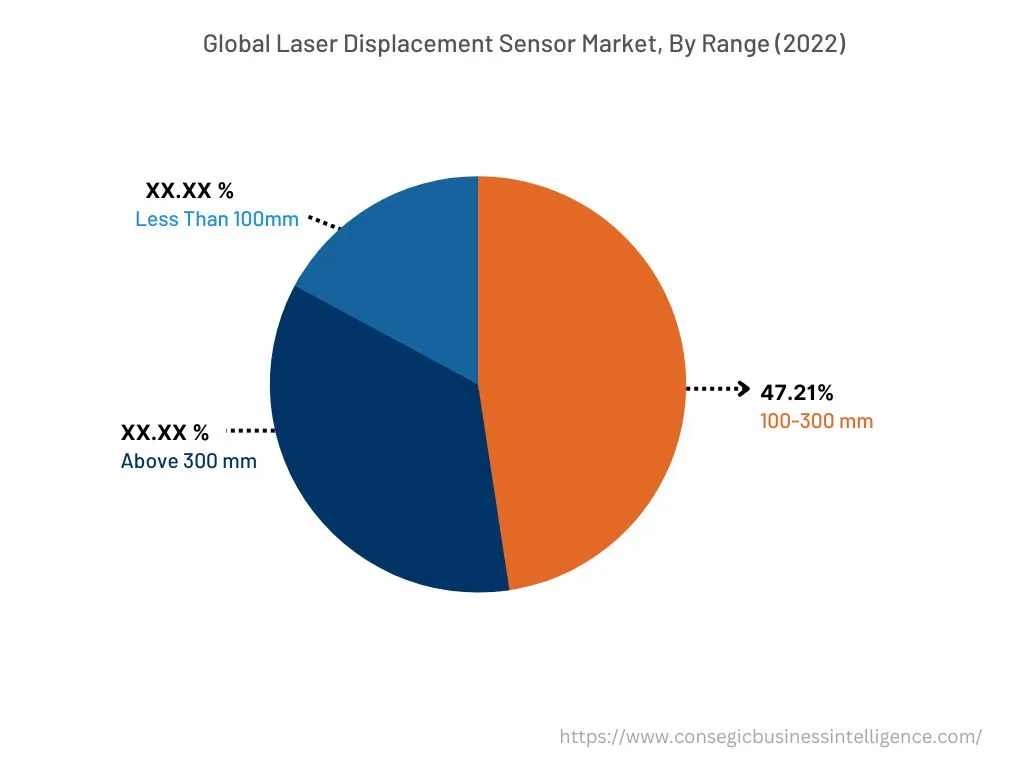
By End-User :
Based on the end-user, the market is segregated into automotive, aerospace & defense, consumer electronics, industrial, and others. The industrial segment accounted for the largest revenue share in the year 2022. Laser displacement sensors are widely used for industrial manufacturing purposes for enhancing the measurement throughput and provide detailed information for process improvement during the manufacturing process. The sensors are used for the detection of small parts, tiny hole detection, and measuring the thickness of objects for various industrial processes. Therefore, the sensors are ideal for automatic inspection, welding seam inspection, and industrial robot process guidance.
The automotive segment is expected to register the fastest CAGR growth during the forecast period. Laser sensors and other non-contact transducers are well suited to measure complex constructions of automotive vehicles parts. The sensors are used for regular tests and measurement of applications including roughness, thickness, and flatness of the vehicles. For instance, in January 2022, ZF Friedrichshafen AG launched next generation camera, radar and LiDAR systems for advanced safety and automated driving intelligence through advanced sensing technologies. Consequently, the deployment of laser displacement sensors for measuring and monitoring fast-moving parts and engine components is accelerating the growth of the market.
By Region :
The regional segment includes North America, Europe, Asia Pacific, Middle East and Africa, and Latin America.
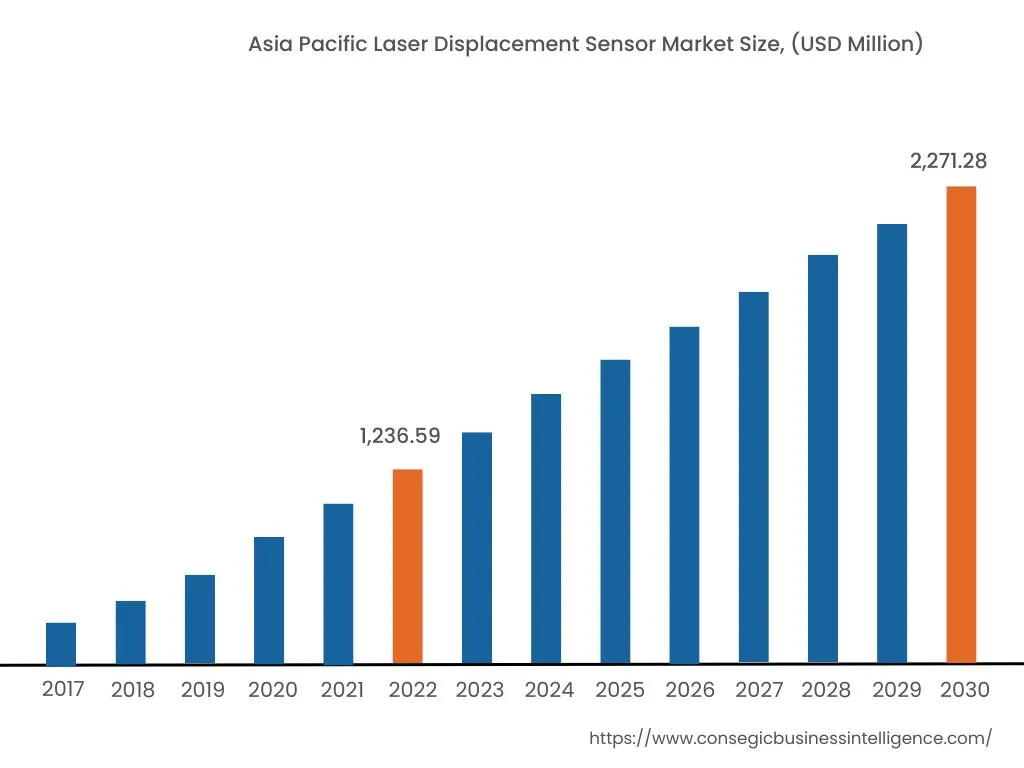
The Asia-Pacific region accounted for the largest revenue share of USD 1,236.59 million in the year 2022. In addition, in the region, China accounted for the maximum revenue share of 31.0% in the same year. The growth of the regional market is attributed to the well-established manufacturing industry in the Asia-Pacific region. As a result, the demand for laser displacement sensors for quality control, inspection, and other critical applications is accelerating the growth of the market. Manufacturers are increasingly producing laser displacement sensors due to the increasing demand for automation and sensing technologies in manufacturing and other industries. For instance, in August 2022, LMI Technologies launched 4k+ high-resolution smart 3D laser line profilers well-suited for measurement of microscopic features and large conveyor applications.
North America is anticipated to register a fastest CAGR of 8.4% during the forecast period. The increasing demand for consumer electronics such as smartphones, laptops, and tablets is driving the growth of the market. Laser displacement sensors are utilized to measure the required height, width, and size of the consumer electronics parts. Laser displacement sensors are used to inspect electronic components and circuit boards for defects or damage. Moreover, technological advancements in sensing technologies in the region is further contributing to the growth of the regional market.
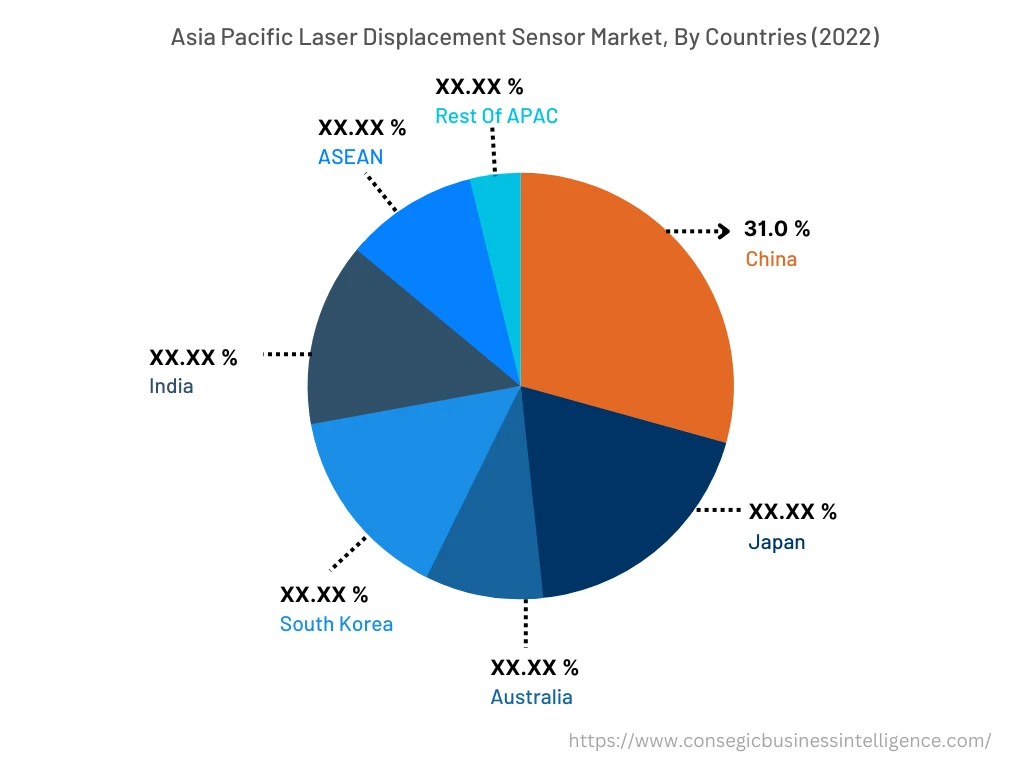
Top Key Players & Market Share Insights:
The laser displacement sensors market is highly competitive with major players providing advanced sensing technologies to the national and international markets. Furthermore, the surge in product innovation, research and development (R&D), and various business strategies, and application launches have accelerated the growth of the laser displacement sensor market. Key players in the laser displacement sensor market include -
- Banner Engineering Corp.
- Cognex Corporation
- Delta Electronics Inc.
- Incorporated
- Keyence Corporation
- Mechanical Technology
- Micro-Epsilon Messtechnik GmbH & Co. KG
- OMRON Corporation
- Panasonic Corporation
- SICK AG
Recent Industry Developments :
- In March 2023, Panasonic Industry Europe GmbH launched new laser distance sensor called HG-F capable of measuring distances of approximately 3m using ToF (Time of Flight) technology enabling detection and monitoring of Cobots (Collaborative Robots) or robot arms.
- In March 2021, iniVation AG launched high-resolution ultra-fast laser profiler called DVL-5000 well-suited for high-speed scanning, robot guidance, quality control, and high-speed inspection.
Key Questions Answered in the Report
What is laser displacement sensor? +
Laser displacement sensors are the devices that measure the width, thickness, curve, and evenness of target objects by detecting the level of displacement. The sensors offer stable and accurate measurement with minimal influence from target colour or material.
What specific segmentation details are covered in the laser displacement sensor market report, and how is the dominating segment impacting the market growth? +
The report consists of segments including range and end-user. Each segment has key dominating sub-segment being driven by the industry trends and market dynamics. For instance, by range has witnessed common 100mm-300mm as the dominating segment in the year 2022, due to its ability to automatically adjust the laser light to provide real time feedback from the target.
What specific segmentation details are covered in the Laser Displacement Sensor market report, and how is the fastest segment anticipated to impact the market growth? +
The report consists of segments including range and end-User. Each segment is projected to have the fastest growing sub-segment being fueled by industry trends and drivers. For instance, by end-user segment has witnessed automotive industry as the fastest-growing segment during the forecast period due to its ability to measure fast moving parts and components of automotive vehicles.
Which region/country is anticipated to witness the highest CAGR during the forecast period, 2023-2030? +
The Asia-Pacific region is expected to register fastest CAGR growth during the forecast period due to the growing demand for accurate and precise measuring and sensing technologies in Asia-Pacific region.
